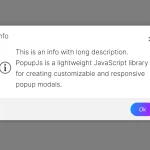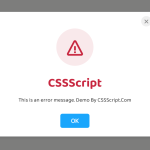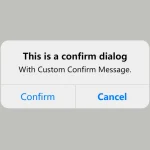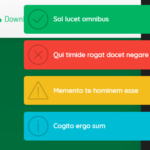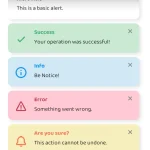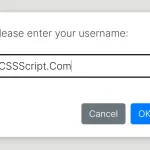| Author: | jsanahuja |
|---|---|
| Views Total: | 2,461 views |
| Official Page: | Go to website |
| Last Update: | June 21, 2019 |
| License: | MIT |
Preview:

Description:
Modal.js is a vanilla JavaScript library for creating highly customizable alert and/or confirmation dialog boxes using plain JavaScript.
More features:
- Custom confirm/cancel buttons.
- Binds custom keys to confirm/cancel actions.
- Supports HTML content.
How to use it:
To get started, include the Modal.css and Modal.js files on the page.
<link href="modal.css" rel="stylesheet"> <script src="modal.js"></script>
Create an alert dialog.
var myAlert = new Modal({
title: "Alert Title",
body: "<center>Alert Message Here</center>",
buttons: [
{
content: "Okay",
classes: "YOUR-OWN-CLASSES",
bindKey: 13, /* Enter Key */
callback: function(modal){
console.log("You just accepted the Alert Modal");
modal.hide();
}
}
],
close: {
callback: function(modal){
console.log("You just closed the Alert Modal");
modal.hide();
}
}
});Create a confirmation dialog.
var myConfirm = new Modal({
title: "Confirm Dialog",
body: "<center>Confirm Message</center>",
buttons: [
{
content: "Cancel",
classes: "YOUR-OWN-CLASSES",
bindKey: false, /* no key! */
callback: function(modal){
modal.hide();
}
},{
content: "Confirm",
classes: "YOUR-OWN-CLASSES",
bindKey: false,
callback: function(modal){
modal.hide();
}
}
],
close: {
closable: false
}
});Show the dialog boxes.
myAlert.show(); myConfirm.show();
All default configurations.
{
title: "Default modal title",
body: "This is the default body. It can include <strong>html</strong>. You can also leave it empty so we will hide it :).",
buttons: [
/*No buttons by default.*/
],
close: {
closable: true,
location: "in",
bindKey: 27,
callback: function(modal){
modal.hide();
}
},
}Available callback functions.
var myAlert = new Modal({
onShow: function(modal){},
onHide: function(modal){ modal.destroy(); },
onCreate: function(modal){},
onDestroy: function(modal){}
});


